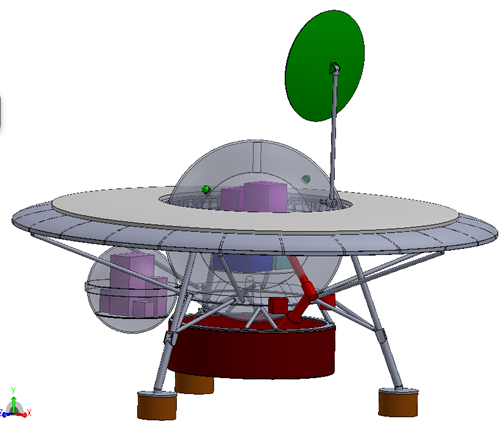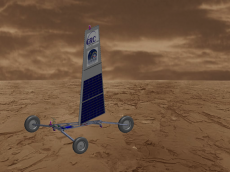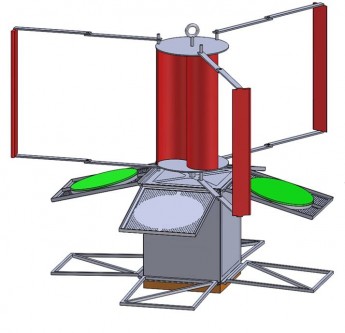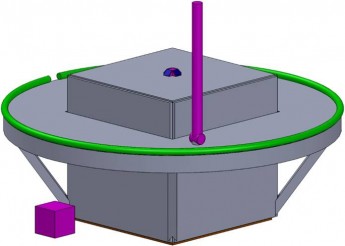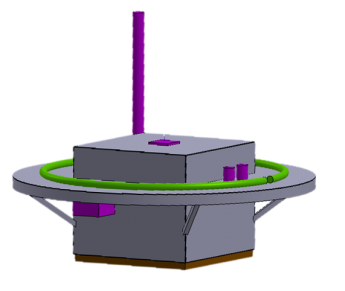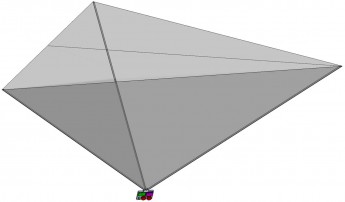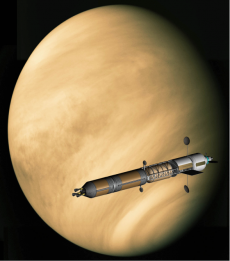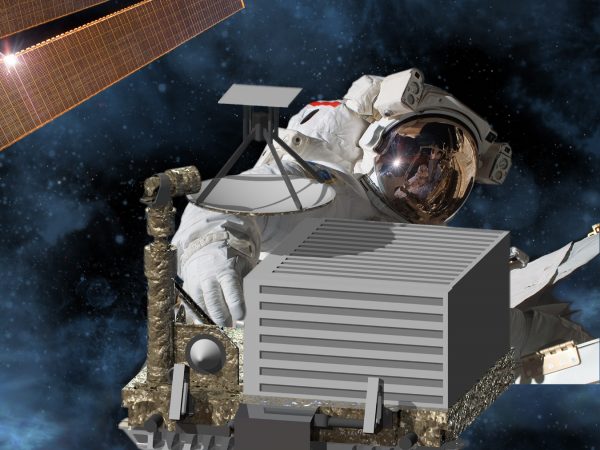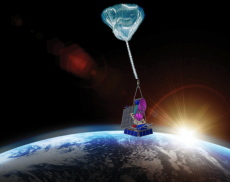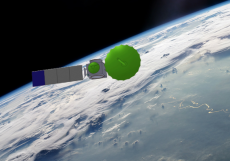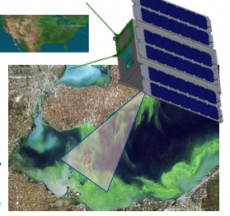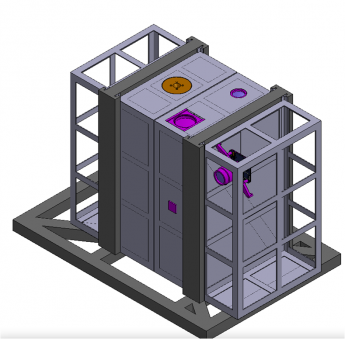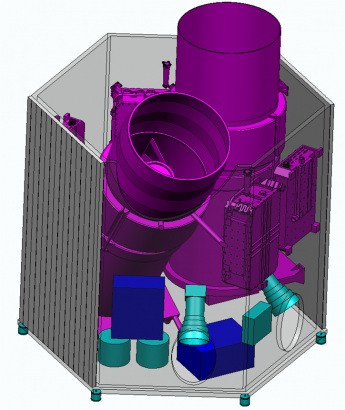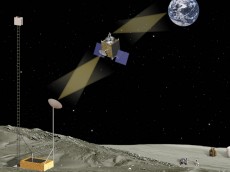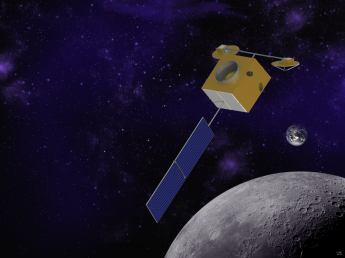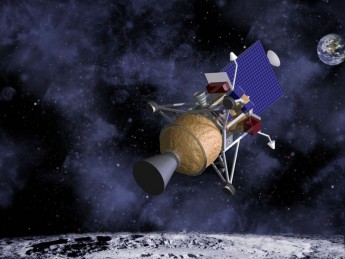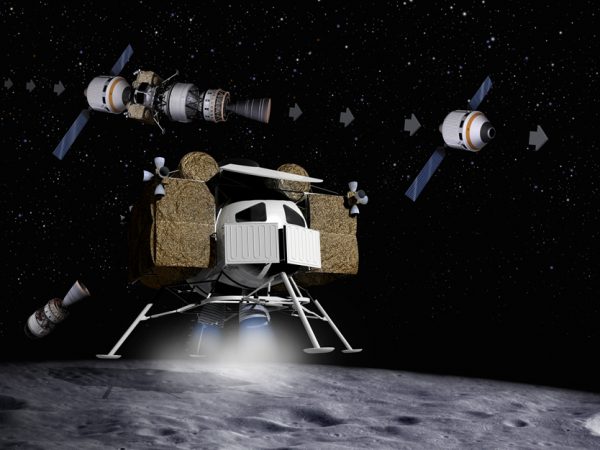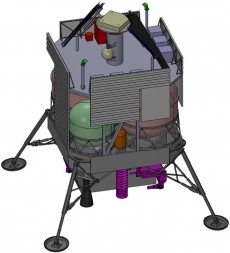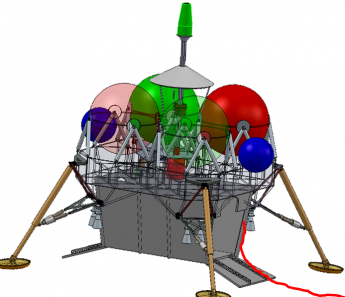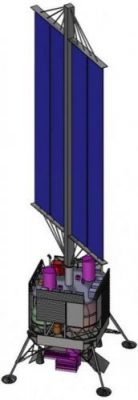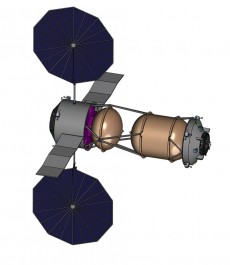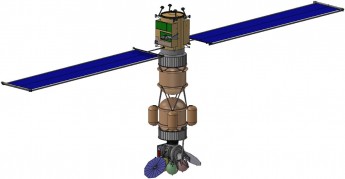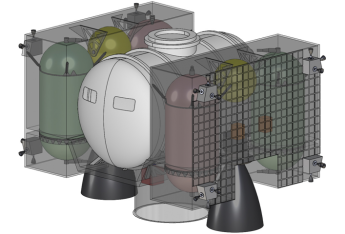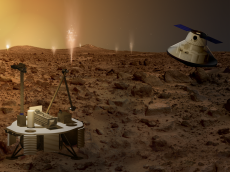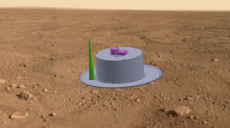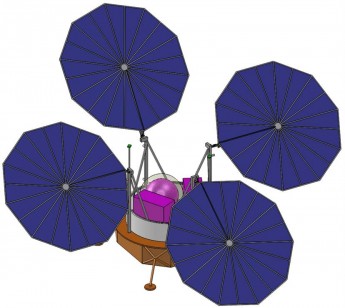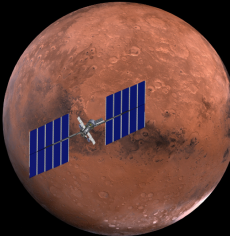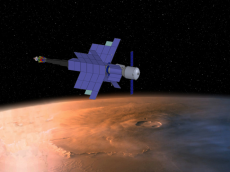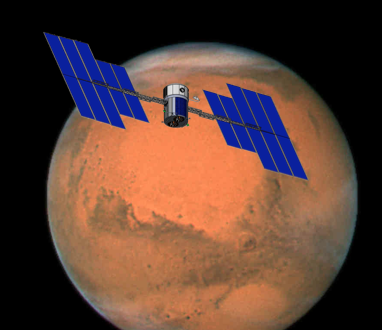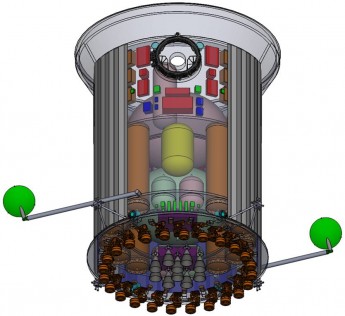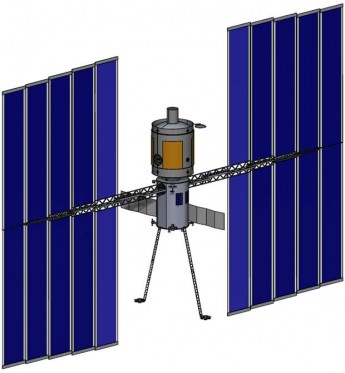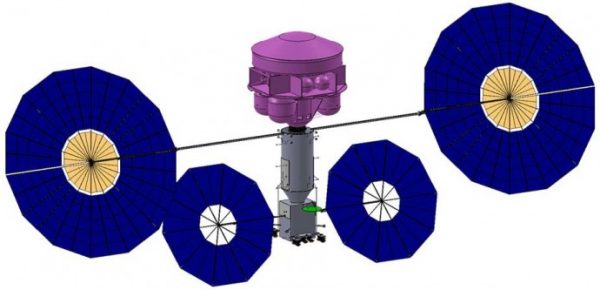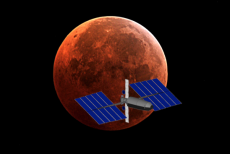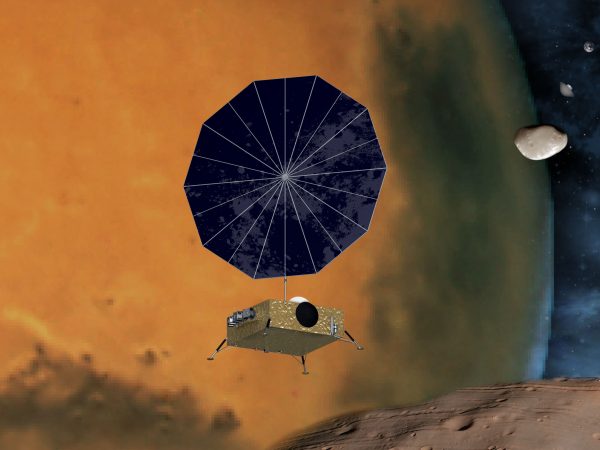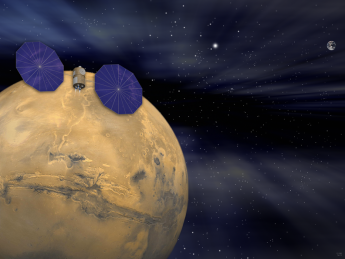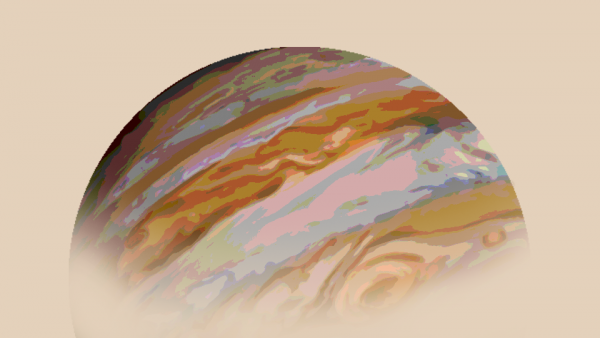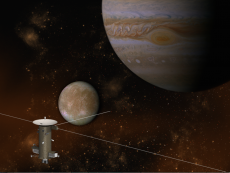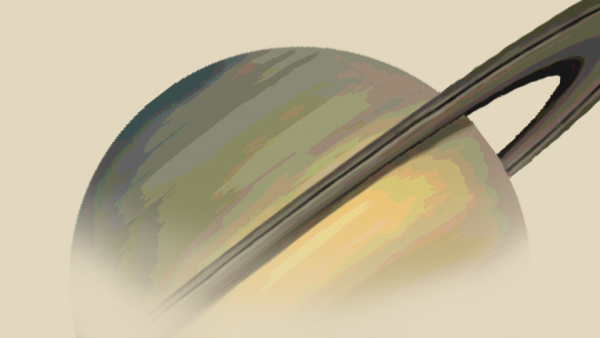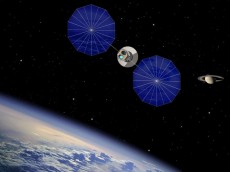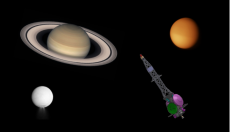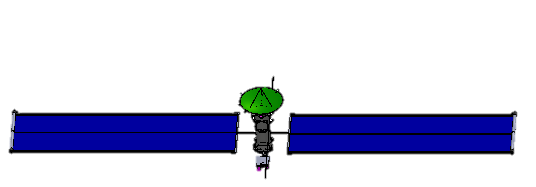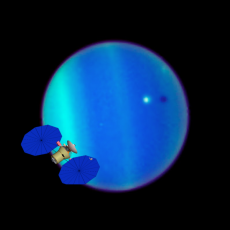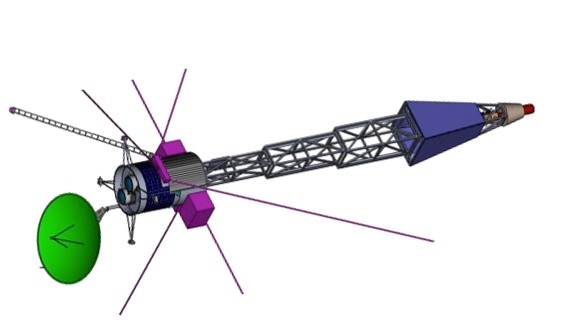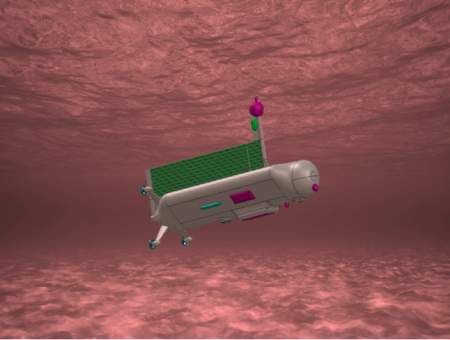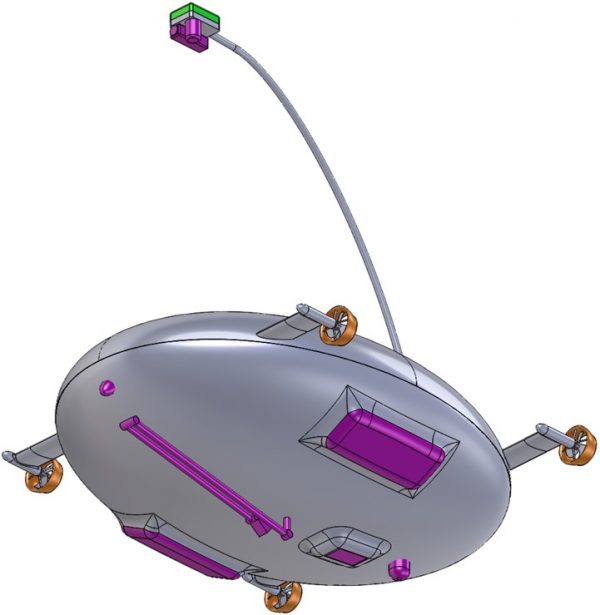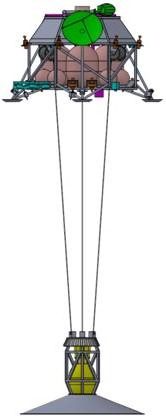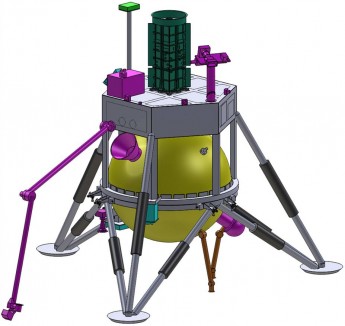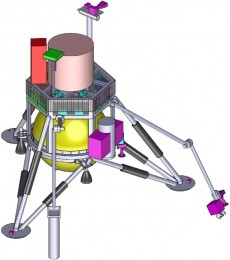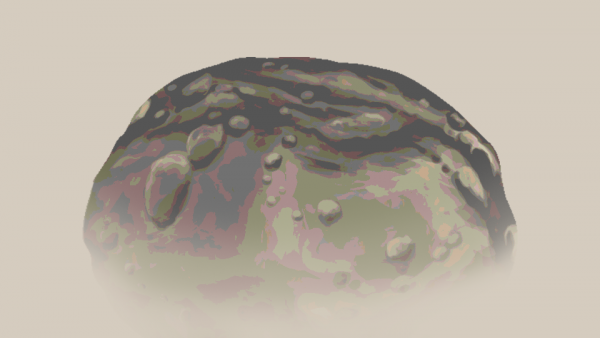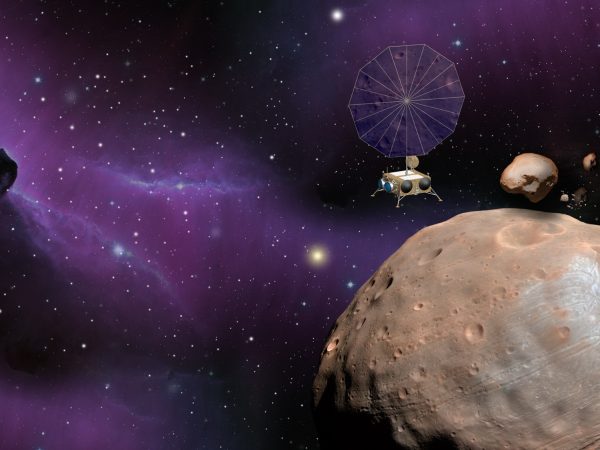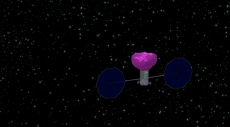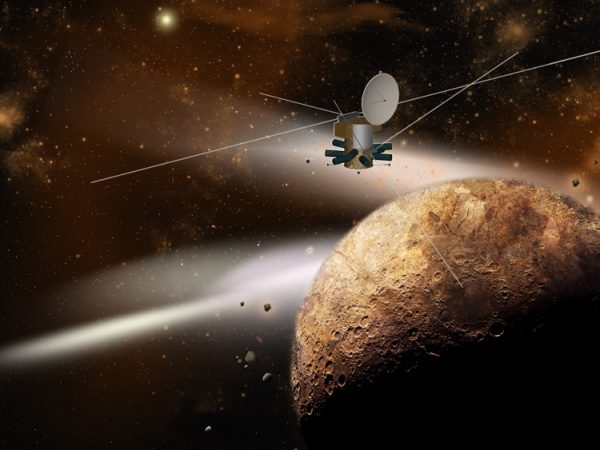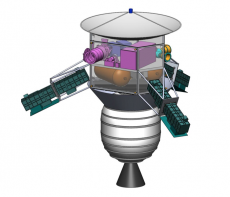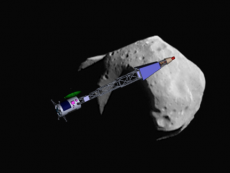Designs by Destination
No matter where you want to explore, Compass is ready to journey with you! Compass has designed missions to every planet of our solar system as well as many of their moons!
Mercury
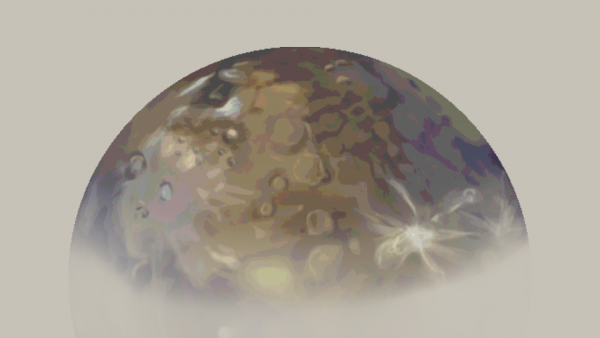
Solar Electric Propulsion (SEP) Stage for Mercury Lander (2009)
SEP Stage to propel a Mercury Lander (Lander designed by the Applied Physics Laboratory at Johns Hopkins University for the Decadal Study). Leverages NEXT xenon gridded ion thrusters and an advanced high-temperature solar array.
Venus
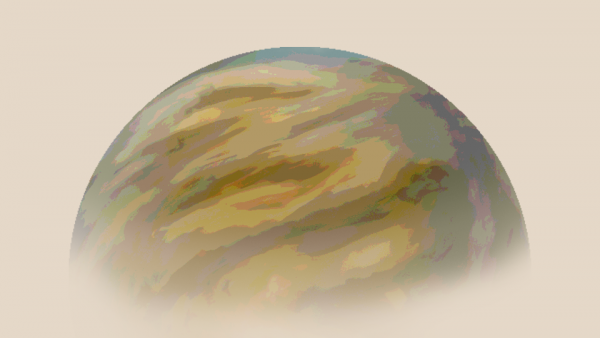
Landers
Advanced Lithium Ion Venus Explorer (ALIVE)- NIAC Venus Lander (formerly EVE) (2012)
Study to evaluate chemical based power systems for keeping a Venus lander alive (providing power and cooling) and functional for a period of days. Partnered with Applied Research Laboratory at Penn State University.
Paper available on NTRS.
Venus Landsailer (Zephyr) (2013)
Venus landsailing rover to explore the Venusian surface. Slowly sails across the plains of Venus using steady 0.5 m/s winds or currents.
Paper available on NTRS.
3-D Printer Files
The following are the .stl files necessary to print the Venus Landsailer on a 3D printer:
Venus Weather Station (2016)
The Venus Weather Station mission is a set of two landed stations operating at high temperature and long duration which will be able to provide periodic environmental and weather data for an entire Venus Morning to Morning (120 days). Deployed from large balloon probe (other options to deploy from dedicated aeroshell).
3-D Printer Files
The following are the .stl files necessary to print Venus Weather Station on a 3D printer:
Seismic and Atmospheric Exploration of Venus (SAEVe) (2017)
Venusian lander design targeting a $100M cost cap. The lander gathers IR, temperature, pressure, and chemical data during descent and for an entire Venusian night/day. Wind and seismic data is added on the surface. An option which includes a camera was also developed!
Long-Lived In-Situ Solar System Explorer (LLISSE) Tech Demo (2019)
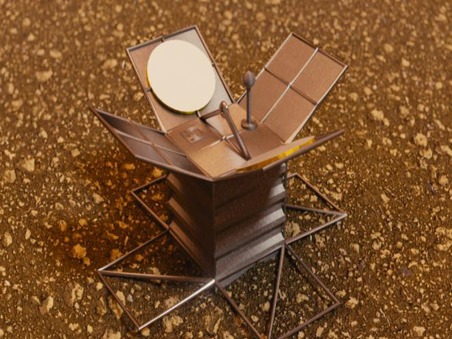
A high temperature tolerant Venus lander technology demonstrator to fly with a Discovery Mission. Designed to fit a $20M cost cap, the lander makes use of SiC electronics to survive the high temperatures and pressures without requiring a pressure vessel.
Venus Bridge Orbiter and Surface Study (2017)
The Venus Bridge seeks to develop a two element mission (long duration lander or aerial vehicle and orbiter relay) which fits in a $200M cost cap. Launch Year: 2025, Lifetime: 120 earth days on surface (~ 1 day/night cycle).
Atmospheric Probes
LEAVES (2018) and LEAVES 2 (2019)
Light, inexpensive radar retroreflectors with rensors to probe Venus’s atmosphere. Senses chemistry, pressure and temperature, as well as tracking wind speed and direction. Conducted as a NIAC study.
Paper available on NTRS.
Crewed Missions
Human Exploration using Real-time Robotic Operations – Venus (HERROV) (2010)
A crewed mission to Venus, based on the previous Compass mission HERRO. Allows for real time investigation of Venus by sending astronauts to orbit the target and telerobotically explore them using robotic systems.
Earth

International Space Station Experiments
Communications, Navigation, and Networking re-Configurable Testbed (CoNNeCT) (2008)
The CoNNeCT flight system (also called SCaN Testbed) was installed on the International Space Station (ISS) Express Logistics Carrier (ELC) inboard upper starboard site via extravehicular activity (EVA). Designed to operate for a minimum of 2 years. The system demonstrated software-defined radios on orbit!
3-D Printer Files
The following are the .stl files necessary to print CoNNeCT on a 3D printer:
High Altitude Balloons
Stratospheric High Altitude Research for Planetary Science (SHARPS) (2012)
High altitude balloon gondola capable of providing a platform for planetary science applications. Delivers gondola with telescope to an altitude of 30 km for the purpose of observing planets and other planetary bodies. Provides a lower cost and longer observation times than current assets.
Science and Communications Orbiters
Small GEO Space Based Relay (SBR) (2013)
Provide one S-band/Ka-band single access relay to a ground system, carried by a dedicated small geostationary satellite. Provides 1.2 Gbps from single Earth orbit user or 80 Mbps from lunar users.
Space Hyperspectral Algae Research Cubesat (SHARC) (2014) and Hypercube (2015)
Cubesats, equipped with a hyperspectral imagers to study the algae blooms in the Great Lakes.
3-D Printer Files
The following are the .stl files necessary to print an HSI Cubesat on a 3D printer:
GTO Smallsat (2016)
Demonstrate the rapid development, integration, and delivery of a low-cost, small satellite – with a spacecraft architecture that could be employed for a variety of missions in the future. Different combinations of propulsion, power, communications, and payload were explored, along with adaptability for different launch providers.
Canopy Height and Glacier Elevation change (CHanGE) (2018)
CHanGE is an instrument concept that would combine high resolution stereo optical imaging with lidar measurements of ice topography and vegetation structure.
Moon
Communication
Lunar Relay Satellite (LRS) & Lunar Communications Terminal (LCT) (2007)
Provides full-time lunar communication, control, and navigation for safe lunar surface outposts and exploration.
LRS: Relays communications between lunar surface assets and the Earth. Provides navigation support for lunar orbiting assets (Orion & Lunar Lander) and surface assets. Two spacecraft operating in a 12 hour frozen elliptical lunar orbit. Data throughput of 100 Mbps from habitat & LCT; 50 Mbps from other lunar surface using space-based router.
LCT: Serves as the communications node for lunar surface assets (Habitats, rovers, crew and science) and provides some navigational support.
Papers available on NTRS: Paper 1 and Paper 2.
Lunar Network Satellite – High Rate (2008)
Spacecraft designed to relay lunar communications and provide navigation support for lunar surface missions including crew outpost, crew sorties, and robotic assets. Two spacecraft in a 24 hr inclined frozen elliptical lunar orbit.
Paper available on NTRS.
Landers and Landed Elements
Low-Cost Lunar Robotic Lander (2006)
Provides a low-cost (~$100 M) capability to place small payloads (~10s of kg) of science or technology demonstrators on the lunar surface. Provides a science payload capability of: 1 week, sunlit, global access, 25 W for 15 kg payload landed on lunar surface.
Paper available on NTRS.
Staged Descent Lunar Lander Concept (2006)
The design that started it all! Compass’s first design delivers a crew of four astronauts to the lunar surface for either a 1-week sortie or 6-month outpost mission. Lunar Capture and Descent Stage (LCADS) used for lunar orbit insertion and 70% of descent burn. 3500 lbs of science and support delivered to lunar surface. Three RL-10 delivered LOx/LH2 engines for terminal descent/ascent.
In-Situ Resource Utilization (ISRU) Concentrator (2019)
A conceptual design for an ISRU system, delivered on a single lander, that produces and stores 10 tons of oxygen per year at the south pole of the moon for users landing 150 m away. Power is provided by a solar concentrator.
Lunar Kilopower Demonstrator (2018)
Demonstrates Kilopower technology on a lunar lander that performs an extended-duration lunar science mission addressing strategic NASA goals.
Lunar In-Situ Resource Utilization (ISRU) (2018)
An ISRU system to produce 6.7t of liquid oxygen per year at the south pole of the moon for users <1 km away.
Crewed Missions and Crewed Mission Support
Lunar Tanker (2018)
A representative cryogenic tanker design (as a point design for future potential future commercial systems).
Lunar Depot (2019)
A representative cryogenic depot design to provide LOX/LCH4 propellants for lunar assets.
Lunar Ascent Vehicle (2018)
Lunar ascent vehicle to return crew to Gateway following lunar excursions.
Mars
Landers and Rovers
Radioisotope Power Systems (RPS) Mars Geyser Hopper (2009)
Design of a landed hopper, cruise deck, and aeroshell for transit and landing at the Martian South Pole. The Geyser Hopper is capable of one hop to investigate geysers. Geyser investigation science package includes cameras, a meteorology package, and MastCAM. Landing site science includes MARDI, LIDAR (laser-radar), and chemical analysis package.
Mars Hard Lander (2013)
RHU (Radioisotope Heating Unit) powered Mars Penetrator design. Demonstrates how RHU-RPS (Radioisotope Power Systems) systems can enable science investigations throughout the solar system.
3-D Printer Files
The following are the .stl files necessary to print Mars Hard Lander on a 3D printer:
- Mars-Hard-Lander-Cover
- Mars-Hard-Lander-Crush-Pad
- Mars-Hard-Lander-Pin
- Mars-Hard-Lander-Plate-and-Bus
Power for Piloted Mars Surface (2016)
Develop a solar power system to support fixed crewed Mars elements for expedition 1 (starting in 2038) with insights on use for expeditions 2 & 3 (total 12 year operations).
In-situ Resource Utilization (ISRU) Power System Demonstrator (2015)
Power System Point Design for a Mars ISRU demonstrator potentially launched as part of an Entry Descent and Landing demonstrator. ISRU plant operates 10 hours per day at the equator and produces & stores 1500 kg of liquid oxygen in 1200 days (accounting for a 20 day dust storm outage).
Crewed
Human Exploration using Real-time Robotic Explorations (HERRO) – Crew Telerobotic Control Vehicle (CTCV) (2009)
Transports crew to and from Mars and provide a telerobotics platform for controlling surface science telerobots from orbit. Provides artificial gravity (0.3 g) and radiation protection for crew during a 500 day orbital stay. Using a 12-hour orbit, two shifts of scientists and teleoperators can explore each side of Mars during each Mars day. The Crew Telerobotic Control Vehicle (CTCV) controls truck and rockhounds (telerobotic geologists) remotely from orbit. Interface for an optional sample recover craft to rendezvous and return samples.
Piloted Mars Solar Electric Propulsion (SEP) (2012)
A crewed mission to deliver six crew from Earth-Moon L2 to an elliptical Mars orbit and back to Earth. Includes a 300 day stay in Mars orbit.
Piloted Nuclear Electric Propulsion (NEP) (2012)
A crewed mission to deliver six crew in an NEP vehicle to and from Deimos. Includes a 400 day stay at Mars.
Mars Solar Electric Propulsion (SEP)-Chemical Human Architecture Team (HAT) (2015)
SLS launched Hall Effect SEP-Chem Vehicle to deliver four crew from Lunar Distant Retrograde Orbit to an elliptical Mars Orbit. Includes 300 day stay at Mars.
Hybrid Solar Electric Propulsion (SEP)/Chemical Vehicle (2017)
Launched on a single SLS, the 400 kW, Hall SEP-Chem Vehicle delivers four crew from Lunar Distant Retrograde Orbit to an elliptical 5 SOL Mars orbit and back to earth. Includes a 300day stay at Mars.
3-D Printer Files
The following are the .stl files necessary to print Hybrid SEP/Chemical Vehicle Designs on a 3D printer:
- Antenna
- array try 1 (print 2)
- Habitat
- Msin bus
- radiator test (print 2)
- thruster better work (print 2)
Hybrid Propulsion Stage (HPS) (2018) and variants
Launched on a single SLS, the 670 kW, Hybrid Propulsion stage delivers four crew from Lunar Distant Retrograde Orbit to an elliptical 5 SOL Mars orbit and back to earth over a 1060 day duration (including a 300 day stay at Mars). The vehicle can also be modified to instead deliver a 40 mt lander to Mars.
Various investigations, or “one-offs” were performed on this design, including:
HPS High Density Electronics Analysis (HIDEA) (2019)
Investigated the design effects of using high density electronics.
HPS LOXLH2 (2019)
Investigated trading our the solar electric propulsion for a liquid oxygen/ liquid hydrogen propulsion system.
HPS Nested Hall (2019)
Investigated trading out the baseline SEP thrusters with those provided by the NEXT-Step program.
HPS VASIMIR (2019)
Investigated trading out the baseline SEP thrusters with VASIMIR propulsion
Crewed Mission Support
High Delta-V Retrofit for Mars Cargo (HDR) (2015)
Combines a high power SEP module with a commercial Block 0.5 Asteroid Return Vehicle to deliver 42mt Mars landers and return chemical stages to Mars in under 1400 days (including spiral out).
Split Solar Electric Propulsion (SEP)/Chemical (2014)
Architecture that utilizes SEP Vehicles to deliver landers to Mars. Pre-positions the chemical return stage for a crewed mission.
3-D Printer Files
The following are the .stl files necessary to print the design on a 3D printer:
Sample Return
In-situ Resource Utilization (ISRU) Mars Ascent Vehicle (MAV) Sample Return (2016)
Demonstrate an ISRU / Hybrid Propulsion design which enables a Mars Sample Return Mission. Uses previous Compass designs, coupled with ISRU.
3-D Printer Files
The following are the .stl files necessary to print ISRU MAV Sample Return on a 3D printer:
Mars Moon Sampler: Phobos/Deimos Lunar Lander (2008)
Mission to determine the origins of Phobos and Deimos. Uses solar electric propulsion (SEP) to travel to the moons and back to Earth. The New Frontiers Class mission returns six surface and interior samples of the moons to the Earth, totaling 1 kg of material. Requires precision landing of the spacecraft on both moons. Returns the samples to Earth by releasing the science capsule during Earth flyby.
Mars Earth Return Vehicle (MERV) (2009)
Vehicle to rendezvous with a Martian sample in low Mars orbit and return it to Earth. Trades propulsion system options between all solar electric propulsion (SEP), SEP chemical, all chemical, and chemical/aerobraking. Completes a rendezvous with orbiting an Sample Collection Pod.
Mars Ascent Vehicle (MAV) Spun Upper Stage (2012)
Designed to minimize the launch mass of the Mars Ascent Vehicle be using a simple spun second stage, which is inertially pointed by the first stage.
3-D Printer Files
The following are the .stl files necessary to print MAV Spun Upper Stage on a 3D printer:
Jupiter
Europa Ice Sounder (EIS)- Discovery Mission (2010)
Radar-equipped Jupiter orbiter performs flybys of Europa to sound the depth of the ice. The final science orbit has a 78 day period with flybys of Europa at periapsis.
Saturn
Solar Electric Propulsion (SEP) Stage (2007)
SEP Stage to deliver a 2400 kg probe on a Saturn trajectory. Relies on the probe for guidance, navigation, and control, command and data handling, and communications.
Titan Saturn System Mission (TSSM): Various
TSSM Fission Power System (FPS) (2014)
Design Reference Mission based on the Titan Saturn System Mission from 2008. Modified to use a 1 kW fission power system.
TSSM Solar Power (2015)
Titan Saturn System Mission using a 80 kW (1AU) Flexible Array Solar Power System.
TSSM: Solar Power Concentrators (2018)
Two Titan Saturn System Mission designs, one using a flexible solar IMM power system and the other using a flexible 2X concentrator solar IMM power system.
Uranus
Uranus Solar Electric Propulsion (SEP) Stage (2010)
SEP Stage to deliver a payload, being designed by the Applied Physics Laboratory, to Uranus.
Neptune
Nuclear Electric Propulsion (NEP) Delivery Vehicle (2020)
NEP vehicle to deliver the Triton Hopper, conduct science and imaging of Neptune and Triton, and provide a communications relay from the Hopper back to Earth.
Ocean Worlds
Earth’s waters are teaming with life, so ocean worlds hold a special fascination for the science community. Compass is ready to explore their surfaces and depths.
Europa
Europa Ice Sounder (EIS)- Discovery Mission (2010)
Radar-equipped Jupiter orbiter performs flybys of Europa to sound the depth of the ice. The final science orbit has a 78 day period with flybys of Europa at periapsis.
Europa Cryobot (also called Tunnelbot) (2018)
The cryobot enables sampling and analysis of liquid water from Europa’s oceans covered by the shallowest ice thickness, or in ice that has been in contact with the liquid oceans in the relatively recent past.
Titan
Titan Submarine (2014)
Titans seas consist of liquid hydrocarbons as opposed to water and therefore provide insight into the history of organic compounds in our solar system. This submarine would be sent to Saturn’s moon Titan to explore its largest Northern Sea, Kraken Mare. This work was funded by NASA Innovative and Advanced Concepts (NIAC).
3-D Printer Files
The following are the .stl files necessary to print a Titan Submarine on a 3D printer:
Paper on NTRS.
Titan Turtle (2016)
Builds on the previous Titan Submarine design to autonomously explore extraterrestrial seas, especially Ligeia Mare and Kraken Mare.
3-D Printer Files
The following are the .stl files necessary to print Titan Submarine II on a 3D printer:
Fission Powered Lander for Titan (2017)
Demonstrate a Titan Explorer Lander using a Kilopower reactor (500We) instead of plutonium systems.
Triton
Triton Hopper (2015)
A two year exploration of one of the solar systems coldest object using radioisotope power system for melting propellants, power and thermal support. Autonomously carry out detailed scientific investigations from pole to pole, including geysers by hopping from location to location.
Paper on NTRS.
3-D Printer Files
The following are the .stl files necessary to print Triton Hopper on a 3D printer:
Triton Hopper Phase II (2019)
A continuation of the Triton Hopper study, this time using a heated Li block to augment the propulsion system while hopping!
Enceladus
Enceladus Radioisotope Power Systems (RPS) Smallsat (2016)
A pair of RPS Smallsats to examine the geophysical and life supporting capability of Enceladus by scanning the south pole and analyzing water plumes.
3-D Printer Files
The following are the .stl files necessary to print Enceladus RPS Smallsat on a 3D printer:
- Bus-Adaptor-RPS-Smallsat
- MMRTG-Panel-RPS-Smallsat
- Radiator-Panel-RPS-Smallsat
- Science-Panel-RPS-Smallsat
- Antenna-Panel-RPS-Smallsat
- Thruster-Panel-RPS-Smallsat
Asteroids
Near Earth Asteroid Sampler (NEARER) (2008)
Solar electric propulsion enabled sample returns from two near Earth orbiting asteroids (Nereus and 1996 FG3) over a 7-year mission.
Fetch: Asteroid Return Solar Electric Propulsion (SEP) Stage (2011)
SEP Stage to rendezvous with and then capture an asteroid. Then returns the asteroid to LEO (Low Earth Orbit). This design, done with the Keck Institute, eventually turned into the Asteroid Rendezvous and Retrieval Mission (ARRM). After ARRM was canceled, much of the Fetch design was rolled into the Power and Propulsion Element (PPE)- the first element of Gateway!
3-D Printer Files
The following are the .stl files necessary to print FETCH on a 3D printer:
Deep Space
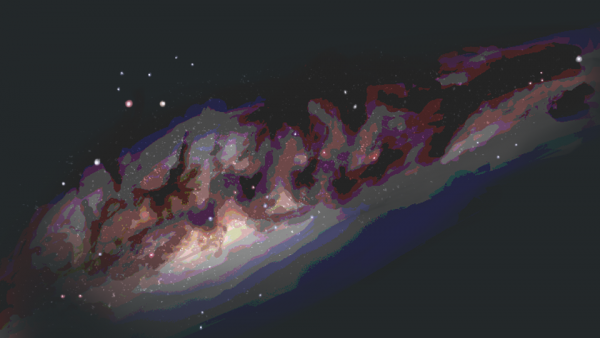
Kuiper Belt Object Orbiter (KBOO) (2009)
Radioisotope Electric Propulsion (REP) orbiter to orbit Kuiper Belt Objects (KBOs). Trades of both REP power sources–ARTG (Advanced Radioisotope Thermal Generator) and ASRG (Advanced Stirling Radioisotope Generator) as well as trades on two KBO Targets–2001 GT322 and 2001 XH255.
Paper on NTRS.
Chiron Orbiter – Decadal Planning Mission (2010)
ASRG (Advanced Radioisotope Thermal Generator) powered, electric propulsion orbiter to conduct science investigations of Chiron.
Nuclear Electric Propulsion (NEP) Centaur (2012)
Nuclear Electric Propulsion (NEP) mission to Centaur. The design investigates the breakpoint between radioisotope and fission powered systems.


